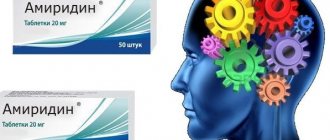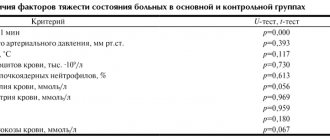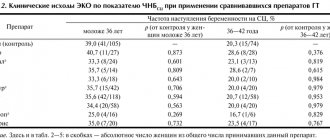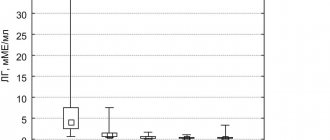Updated: 04/23/2021 15:13:41
Expert: Abramova Tsilya
Gliatilin and Cerepro are drugs from the group of nootropics. If you look at the instructions for use, you will notice that the composition of these products is almost identical. These drugs have similar indications, recommendations for use, and side effects. The only difference is the price - Gliatilin costs almost twice as much as Cerepro. So maybe it’s worth buying the medicine cheaper – and saving money?
Let us be clear right away: cost should not be the only criterion for choosing a medicine. It is no coincidence that Gliatilin is worth its price. Clinical studies have shown that it more effectively copes with the task - eliminates the consequences of trauma, stroke and other brain diseases. But Cerepro shouldn’t be written off either. It is weaker, but this does not prevent doctors from prescribing it for certain conditions and achieving good results.
Experts from our magazine analyzed the freely available results of clinical trials and found out how Gliatilin differs from Cerepro, which remedy is better and why it is not always possible to save on treatment. Let's compare the selected drugs and figure out the problem together.
Principle of action of Gliatilin
The action of the drug is aimed at neural connections in the human brain. After being absorbed into the blood, the active substance, choline alfoscerate, reaches the brain, where it enters into chemical reactions. As a result of the formation of bonds, glycerol phosphate and choline are released. During the biotransformation process, phosphatidylcholine and acetylcholine are synthesized. The first substance increases the elasticity of cell membranes and their permeability. And the second substance is one of the most important nerve mediators.
Taking Gliatilin activates blood circulation processes in the brain, which ensures rapid restoration of lost functions. Most of the substance is eliminated by the respiratory system, along with carbon dioxide. Residues - with waste products.
Efficacy of the drug: which product works better?
An interesting clinical study was presented in the Russian Medical Journal on December 15, 2011. The author (Ershova A.K.) compared the bioequivalence of Gliatilin and Cerepro. The experiment was carried out on 140 mice. Two models were used in the work: a state of acute hypoxia (lack of oxygen) and local ischemia (cessation of blood flow in a separate area) of the brain. It turned out that Gliatilin copes better with the consequences of ischemia and hypoxia. In particular, focal neurological symptoms developed 2 times less often in the group that received the original drug. Translated into human diseases, this means that Gliatilin will cope better with cerebral circulatory disorders than its generic Cerepro.
What is the reason for this effect of the original drug? Researchers say it's all about its structure. Gliatilin is the phosphate form of choline. In this form, choline (a neurotransmitter, a precursor of acetylcholine, an important component of the nervous system) more easily penetrates the blood-brain barrier and accumulates in the brain. Cerepro also passes into the brain tissue, but in lower concentrations. The generic first needs to go from the hydrate form to the phosphate form, and this is a very energy-consuming process. This transformation almost completely exhausts the supply of freely circulating phosphates in the blood. Cerepro enters the brain - but not in the concentration or time needed to achieve maximum effect.
Indications for the use of Gliatilin
Gliatilin is prescribed for diagnosed disorders of the blood supply to the brain, which can be manifested by confusion, memory loss and other typical symptoms. Diseases and conditions that are direct indications for taking the drug:
- traumatic brain injuries leading to impaired consciousness, post-traumatic coma, dizziness;
- ischemic stroke, leading to necrosis of parts of the brain;
- dementia;
- age-related speech disorders;
- bouts of disorientation.
Patients taking gliatilin for long courses showed improvement in their condition, restoration of thought processes, and return of memory.
conclusions
Let's summarize:
- Gliatilin is an original drug. Its effectiveness has been confirmed by clinical studies. It copes well with the consequences of injuries, stroke and other conditions associated with hypoxia and cerebral ischemia.
- Cerepro is a generic drug. It differs slightly in composition. Its effectiveness is lower, although the scope of application remains the same as that of the original.
Which remedy is better is up to you to decide together with your doctor. Cerepro is cheaper, Gliatilin is more effective. In some cases, a generic is sufficient - for example, for moderate cerebrovascular disorders. In difficult situations, it is better not to save money and purchase the original drug.
Instructions for use of Gliatilin
The instructions recommend long-term use of the drug, since restoration of brain function takes time. The minimum course is 3 months. It can be extended up to six months. As a rule, patients are prescribed the drug in the form of capsules for oral administration. But due to the fact that the capsules themselves are quite large, not every patient can absorb them, for example:
- child;
- a patient with a swallowing reflex disorder;
- patients who have suffered an ischemic stroke with a high degree of severity of damage.
In addition, unconscious and comatose patients are also unable to swallow the drug. In such cases, an alternative is prescribed - a solution for drip administration. 1 ampoule is diluted with 50 ml of saline solution. The rate of administration is no more than 80 drops per minute.
When prescribing capsules containing 400 mg of the active substance, the course consists of two to three doses per day. The medicine should be taken after meals. Each capsule is covered with a dense layer of soluble shell, which protects the active components from the aggressive environment of gastric juice and duodenum. Once in the large intestine, the coating disintegrates and releases the drug, from where it is easily absorbed into the bloodstream and reaches the brain. Therefore, the idea of cutting the capsule and squeezing the contents into a puree-like food to make it easier to take is impractical. The acidic environment of the stomach will destroy all the benefits of the substance.
Price for the drug Gliatilin
In the absence of Gliatilin in the pharmacy, the drug can be replaced with no less effective analogues with the same active ingredient:
- Choline alfoscerate. Sold in the form of a solution for intramuscular or drip administration. Each ampoule contains 250 mg/ml of active substance, ampoules are 4 ml each. There are 10 pieces in a package. The cost of this analogue is slightly higher than 550 rubles per package.
- Nooholin Rimpharm. Ampoules do not differ in volume and content of active substance. There are usually 3 ampoules in a package, the cost of the drug in the described dosage is from 350 rubles per package.
- Cereton. Available in capsules, each dose unit contains 400 mg of the active ingredient. A package of 56 capsules costs an average of 1,400 rubles. The solution for intravenous and intramuscular administration is packaged in 4 ml ampoules, each of which contains 0.25 ml of the substance. A pack of 5 ampoules can be purchased for 580 rubles.
- Holitylin 400 mg. Sold in capsules, 28 or 14 pieces per package. The dosage and number of doses does not differ from the prescribed regimen for taking Gliatilin. The cost of a package containing 14 doses varies from 405 rubles.
- Cerepro. It can be found both in ampoules and capsules. The amount of active substance in 1 dose does not differ from what is contained in analogues. A package of 28 capsules is sold at a price of 1,000 rubles.
Buy Gliatilin solution intravenously and intramuscularly 1g 4ml No. 3 in pharmacies
Gliatilin Buy Gliatilin in pharmacies DOSAGE FORMS solution for intravenous and intramuscular administration 250 mg/ml solution for injection 1g
MANUFACTURERS Italfarmaco S.p.A. packaged by Pharmacor Production (Italy) Italfarmaco S.p.A. (Italy)
GROUP Nootropic drugs
COMPOSITION Active substance: Choline alfoscerate.
INTERNATIONAL NON-PROPENTED NAME Choline alfoscerate
SYNONYMS Gleatser, Delecit, Noocholin Rompharm, Choline alfoscerate, Holitylin, Cerepro, Cereton
PHARMACOLOGICAL ACTION Pharmacodynamics. Gliatilin - choline alfoscerate is a centrally acting cholinomimetic with a predominant effect on the central nervous system. The drug contains 40.5% choline, released from a compound in the brain; choline is involved in the biosynthesis of acetylcholine (one of the main mediators of nervous excitation). Alphoscerate is biotransformed to glycerophosphate, which is a precursor to phospholipids. Acetylcholine has a positive effect on the transmission of nerve impulses, and glycerophosphate is involved in the synthesis of phosphatidylcholine (membrane phospholipid), resulting in improved membrane elasticity and receptor function. The drug increases cerebral blood flow, enhances metabolic processes and activates the structures of the reticular formation of the brain, and also restores consciousness in case of traumatic brain injury. It has a preventive and corrective effect on the factors of involutional psychoorganic syndrome, such as changes in the phospholipid composition of neuronal membranes and a decrease in cholinergic activity. Thus, pharmacodynamic studies have shown that the drug acts on: synaptic, including cholinergic transmission of nerve impulses (neurotransmission); plasticity of the neuronal membrane; receptor function Pharmacokinetics. Absorption when taken orally - 88%; easily penetrates the blood-brain barrier, accumulates mainly in the brain (concentration in the brain reaches 45% of the level in the blood), lungs and liver; 85% is excreted by the lungs in the form of carbon dioxide, the rest (15%) is excreted by the kidneys and through the intestines. Does not affect the reproductive cycle, does not have teratogenic or mutagenic effects.
INDICATIONS FOR USE Acute period of traumatic brain injury, mainly with brain stem lesions (including impaired consciousness, coma); disorders of cerebral circulation of the ischemic type (acute and recovery period) and hemorrhagic type (recovery period), degenerative and involutional psychoorganic syndromes and consequences of cerebrovascular insufficiency, such as primary and secondary disorders of mnestic functions, characterized by memory impairment, confusion, disorientation, decreased motivation , initiative and decreased ability to concentrate; changes in the emotional and behavioral sphere: emotional lability, increased irritability, decreased interest, senile pseudomelancholy; multi-infarct dementia.
CONTRAINDICATIONS Hypersensitivity to the components of the drug. Use during pregnancy and lactation.
SIDE EFFECT Nausea (as a result of dopaminergic activation), in this case the dose of the drug is reduced. Allergic reactions are possible. As a rule, the drug is well tolerated even with long-term use.
INTERACTIONS No drug interactions have been established.
METHOD OF APPLICATION AND DOSAGE Injections intramuscularly or intravenously (drip). For adults. For acute conditions: intramuscularly at a dose of 1000 mg (1 ampoule) per day or intravenously from 1000 mg to 3000 mg per day. When administered intravenously, the contents of one ampoule (4 ml) are diluted in 50 ml of physiological solution, the infusion rate is 60-80 drops per minute. The duration of treatment is usually 10 days, but if necessary, treatment can be continued until positive dynamics appear and it is possible to switch to oral capsules.
OVERDOSE Symptoms: nausea. If this symptom appears, it is recommended to reduce the dose of the drug.
SPECIAL INSTRUCTIONS Impact on the ability to drive a car or other machinery. Does not affect the patient's ability to engage in potentially hazardous activities.
STORAGE CONDITIONS Store out of the reach of children at a temperature not exceeding 25 C.
Replacing injections with capsules
When the patient is unable to swallow on his own or his mental state is impaired, due to which he refuses to take pills, intramuscular or drip administration is prescribed. This treatment regimen can be replaced with capsules if the patient is recovering and his swallowing function allows him to take large pieces of food. The same applies to patients in a coma - as soon as the patient regains consciousness and begins to feed on his own, Gliatilin is transferred to capsule form. This allows the patient to go home under the supervision of a local specialist.
How are they transferred?
The instructions for use of nootropic drugs do not state any significant side effects. Clinical trials also show that both treatments are well tolerated. Some patients experience nausea - the result of the natural effect of the drug components on the central nervous system. This condition is not dangerous and does not require discontinuation of the drug.
It is not known for certain which of the agents under consideration is better tolerated. Nausea occurs both with Cerepro and with the use of the original Gliatilin. Allergic reactions are possible.




